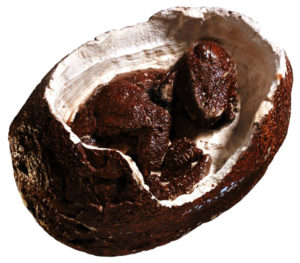A different approach to dinosaur embryology has revealed another layer to our understanding of the demise of dinosaurs and rise of mammals as a result of the end-Cretaceous mass extinction event. In a 2017 Proceedings of the National Academy of Sciences paper, a group of researchers led by Gregory Erickson hypothesized that dinosaur eggs may have growth lines present on embryonic teeth that could be used to determine incubation times.

Not much is understood about dinosaur embryology, aside from what is known about birds. This is in part because fossils of dinosaur eggs, especially those containing embryonic skeletons, are among the rarest in the world. Despite this difficulty, using these fossils to refine estimated incubation times of dinosaur embryos can shed light on their development, life history and evolution.
Historically, paleontologists have assumed that dinosaur incubation periods were rapid based on their extant counterparts, birds. Considered living dinosaurs, birds are a logical surrogate from which to extrapolate dinosaur incubation times. It is important to note that embryonic incubation in birds is different from other living relatives of dinosaurs, modern reptiles. While reptile embryos develop slowly, birds differ by laying fewer, larger eggs with rapid incubation.
The accelerated incubation results from warmer temperatures in the nest and faster embryonic metabolism. In terms of survival, this strategy means there is less time for predators or other environmental dangers to interfere with developing eggs. Additionally, hatchlings are larger and more fit, reaching adult size and reproductive maturity more quickly.
Fossilized dinosaur eggs and the associated embryos have been analyzed to estimate incubation times based on typical incubation periods of birds relative to values such as egg mass or the size of hatchlings or adults. However, there has not been a direct method to determine the embryonic incubation period for dinosaurs.
In this study, the researchers applied a method that had been used to measure the duration of growth in the embryonic teeth of mammals and crocodiles. This technique uses incremental lines of von Ebner (lines resulting from layers formed during daily cycles of mineralization in the embryonic teeth) to measure time of growth.
These lines reflect growth in embryonic teeth similar to how tree rings reveal age, but on a scale of days rather than years. Tree rings alternate between thick and thin according to wet or dry parts of a year. Lines of von Ebner also result from alternating thick and thin layers that correspond to diurnal surges in mineralization activity.
The researchers found lines of von Ebner present in embryonic dinosaur teeth and used data from reptiles to determine incubation times in two dinosaur species, Protoceratops andrewsi and Hypacrosaurus stebingeri. These species were chosen because their eggs represent almost the entire size range known for dinosaurs, with H. stebingeri having eggs the size of a volleyball!
Analysis of the growth lines indicated slow incubation times more similar to those found in reptiles. Estimations for H. stebingeri egg incubation are 82 days using regression of incubation period versus egg size in living birds; the von Ebner lines show that incubation was closer to six months.
More interesting than these results are the authors’ ideas about the significance of these findings. The contrast in incubation times between birds and dinosaurs illustrates an important point about the relationship between these two groups. As Erickson stated during an interview on NPR’s Science Friday, “Birds are dinosaurs, but dinosaurs are not birds.” The authors propose that birds probably evolved to have more rapid incubation before the mass extinction event that brought an end to the age of the dinosaurs.
Furthermore, the slower incubation of non-avian dinosaur eggs likely contributed to the difficulties faced by these animals after the asteroid impact and their extinction. Reproduction rates lagged because long incubation times increased opportunities for predators and environmental dangers like flooding or drought to influence the survival of eggs or parents attending to them.
This, coupled with large resource requirements for reproduction (in an environment with increasingly scare food sources) likely played a role in non-avian dinosaurs’ ability to compete with birds, reptiles and mammals that had faster generation times. Ultimately, slow incubation times were another deadly card in the hand the dinosaurs held in the face of the end-Cretaceous cataclysm.
Reference
Erickson, G.M., Zelenitzky, D. K., Kay, D. I. and Norell, M. A. (2016) Dinosaur incubation periods directly determined from growth-line counts in embryonic teeth show reptilian-grade development. PNAS. Oct 25, Epub ahead of print.
Latest posts by Darcia Schweitzer (see all)
- Cytochrome P450 Inhibition: Old Drug, New Tricks - May 5, 2022
- Firefly Luciferase Sheds Light on Development of New Malaria Treatments - April 5, 2021
- How to Train Your Instrument Service Team in a Pandemic - February 1, 2021
